For all of our excitement about the ways that DAOs could usher in a revolution of collective action, we should remember: they wouldn’t be the first one, and they won’t be the last.
Our current world is designed primarily around large centralized structures like national governments, universities, and corporations. But this hasn’t always been the case—cycles of decentralization and centralization define the ebb and flow of major periods of human history.
We seem to be in a late-stage period of the modern era, where centralized institutions are failing. So it’s natural to run in the other direction, to swing the pendulum toward decentralized maximalism. Maximalism is the strategy of a cancer cell. Successful complex systems are diverse, permeable, and inherently pluralistic.
If we’re going to run screaming from centralization, we need to have a sense of where we are running towards as well as what we are running from. Movements focused on abandoning centralized structures without suitable replacements tend to end in apathetic collective action failure, or worse, mob rule. If we are to avoid the proverbial guillotine, we should learn what has worked and failed in other decentralized organizations. We need to ask ourselves:
In what ways can decentralized organizations outcompete more centralized ones?
Ideologies don’t win by claiming superiority—they win by demonstrating that they can solve real problems more effectively than the alternatives. So it’s worth deeply understanding what has actually made decentralized organizations better (and worse) than the available alternatives.
Principles of successful decentralized organizations
Here are four very different kinds of organizations that have something to teach us about building DAOs:
-
Valve, the company behind Steam
-
the US Marine Corps
-
intentional co-living communities
Each of these organizations operates in decentralized ways that result in better outcomes than more centralized peers. They have created flexible, adaptable, creative, and capable evolutionary systems that can outperform more rigid hierarchies in rapidly changing environments.
This wide range of organizational types shows the different ways that decentralization can manifest as a strength. By looking at the commonalities in their principles, we can understand what makes decentralized organizations successful. Here are a some of the principles they all have in common:
-
Recruit the best people
-
Help members self-organize
-
Empower mission-driven leaders
-
Have a bias towards action
-
Play infinite games
Note that none of these principles are about decentralization absolutism. They are about finding the right balance between decentralized self-organization and flexible leadership structures that create Schelling points for collective action. Let’s explore each one in a bit more detail.
1 - Recruit the best people
There’s one principle that every successful organization seems to agree on: great organizations are made up of great people. No amount of organizational design can make up for people who lack the skills, ambition, and passion to accomplish great things. One of the most triumphant passages of Valve’s employee handbook reads:
You have the power to green-light projects. You have the power to ship products. A flat structure removes every organizational barrier between your work and the customer enjoying that work.
If you’re thinking to yourself, “Wow, that sounds like a lot of responsibility,” you’re right. And that’s why hiring is the single most important thing you will ever do at Valve. Any time you interview a potential hire, you need to ask yourself not only if they’re talented or collaborative but also if they’re capable of literally running this company, because they will be.
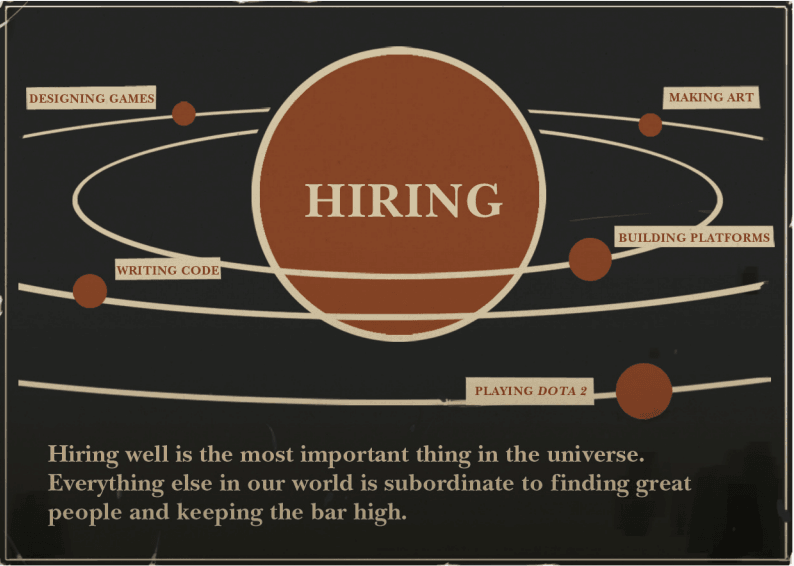
As far as I can tell, “engage amazing humans” is the core strategy of all great organizations, and especially those that aspire to high levels of decentralization. Organizations are made up of people, so if you want to build great things, it’s natural that the first rule is to work with great people.
Working with great people makes your life easier. Great people are smarter and more competent than you at the things they spend time on. They see around corners you didn’t know existed. They deliver excellence in ambiguous situations without guidance. They have strong vibes and attract each other with these vibes.
Companies like Valve and Amazon, elite military units like the US Marines, and co-living environments like intentional communities all draw boundaries around themselves and carefully evaluate who they let in. By constantly attempting to raise the bar, they can keep scaling without the need for more structure and rules. From Valve again:
We believe that if we’re careful, it will work better and better the larger we get. This might seem counterintuitive, but it’s a direct consequence of hiring great, accomplished, capable people. Getting this to work right is a tricky proposition, though, and depends highly on our continued vigilance in recruiting/hiring. If we start adding people to the company who aren’t as capable as we are at operating as high-powered, self-directed, senior decision makers, then lots of the stuff discussed in this book will stop working.
DAOs often attempt to be permissionless, allowing anyone to join the community. Maintaining openness, permeability, and an inclusive approach to newcomers allows DAOs to grow quickly, increase diversity, and progressively decentralize. But there’s a clear tension between bringing in the best people and maintaining an open and accessible community:
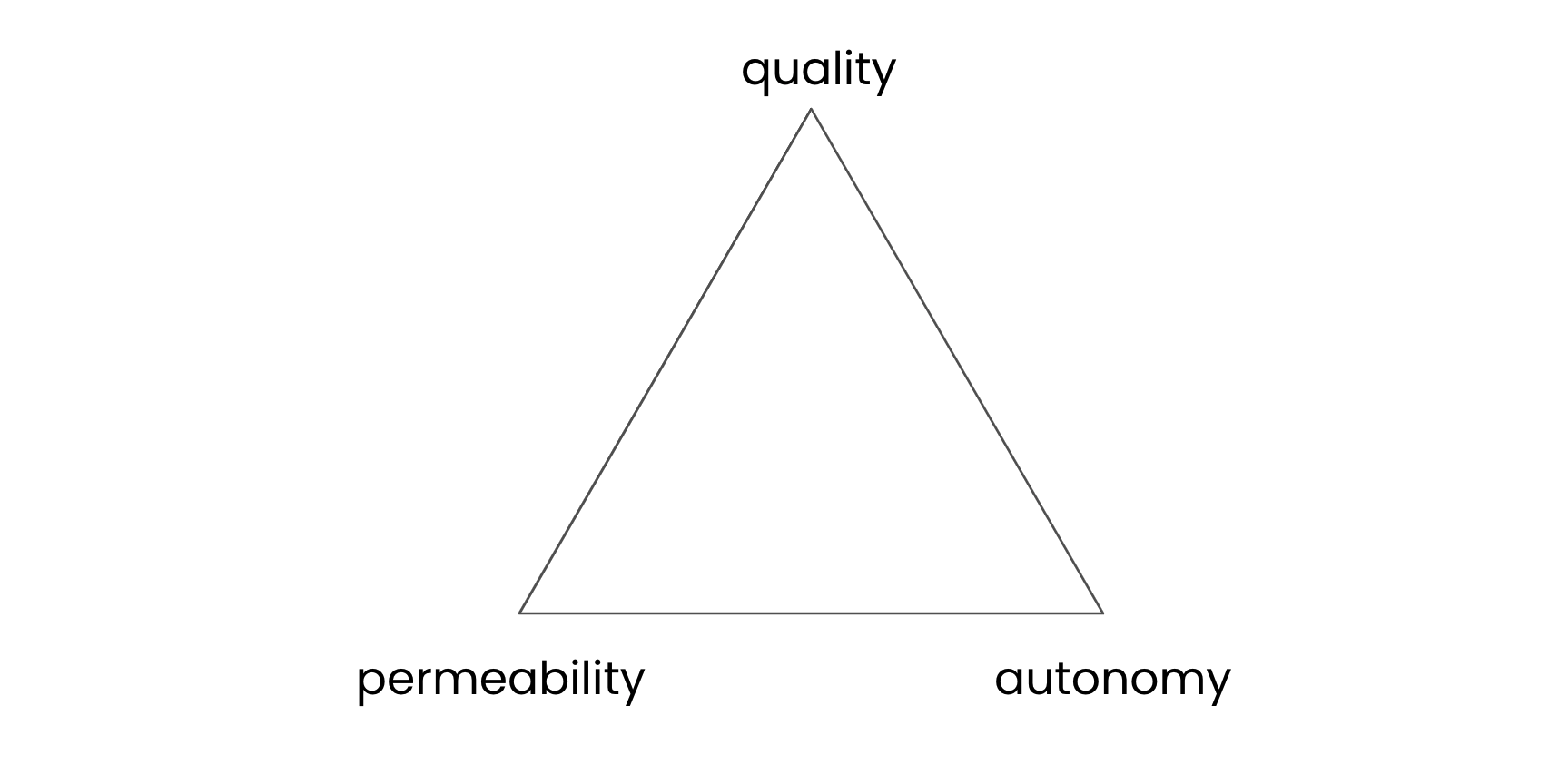
I think the best solution we have to solve for this balance is contributor proof-of-work. Proof-of-work, in this context, refers to the ability for new community members to demonstrate their capabilities and increase the scope of their work as they build trust within the community. By creating systems for self-organizing teams to publicly accomplish the organization’s goals, DAOs can build feedback loops for strong contributors to succeed and positively reinforce the organization's culture, capabilities, and scalability.
2 - Help members self-organize
Once you are surrounded by great people, you can work together to build systems for effective collective action. In order to self-organize, people need:
-
Clearly defined missions
-
Small groups executing at the edges
-
Information accessibility
-
Minimum viable self-governance
Clearly defined missions
Like a slime mold growing towards an available source of food or an oak tree growing towards sunlight, the first thing self-organizing systems need is a goal to grow towards.

Jim Mattis, a US Marine who served as Secretary of Defense, helped define the US military’s counterinsurgency (COIN) doctrine. COIN is an approach to warfare designed to react to highly decentralized terrorist networks. This decentralized military doctrine considers clearly defined missions to be the most important prerequisite for allowing groups to self-organize, because no one can coordinate without a shared understanding of the goal. From Mattis’ memoir, Call Sign Chaos:
The correct exercise of independent action requires a common understanding of both the mission and intent of what the mission is expected to accomplish.
This is why the most successful DAOs so far are organized around strong memes that give members a shared sense of purpose and mission. At Cabin, we are experimenting with a city council that defines objectives for each season and creates budget allocation for those objectives.
Small groups executing at the edges
Once participants have a sense of the mission, they can get together in groups and attempt to accomplish it. Successful groups tend to be small and purposeful. More people does not usually result in better outcomes, because coordination costs increase geometrically. This coordination cost is the flip side to Metcalfe’s Law:
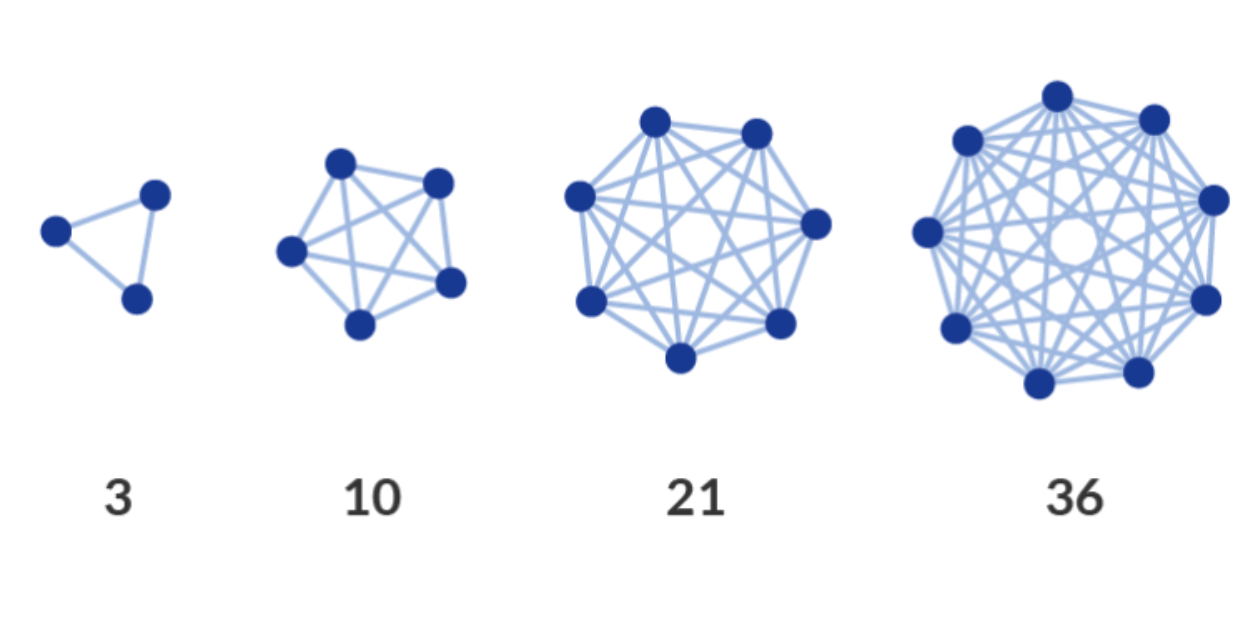
If you ask people what group sizes they like working with, they will generally tell you numbers between 2 and 12 people. Amazon is well known for popularizing the term two pizza team to describe this concept (though at Cabin, we prefer one sauna teams). DAOs can be thought of as constellations of these small teams, sometimes called pods, squads, guilds, or—if you want bad lore—subDAOs.
Information accessibility
Allowing people to self-organize into small teams requires them to have access to information and the ability to execute autonomously. Information access may be the most underestimated benefit of DAOs. Blockchains, by nature, are public ledgers. This means that DAOs, by nature, operate with high degrees of transparency about resource allocation. This is a particularly important breakthrough for DAOs because information transparency and accessibility, especially for newcomers, is a weakness of decentralized organizations like Valve:
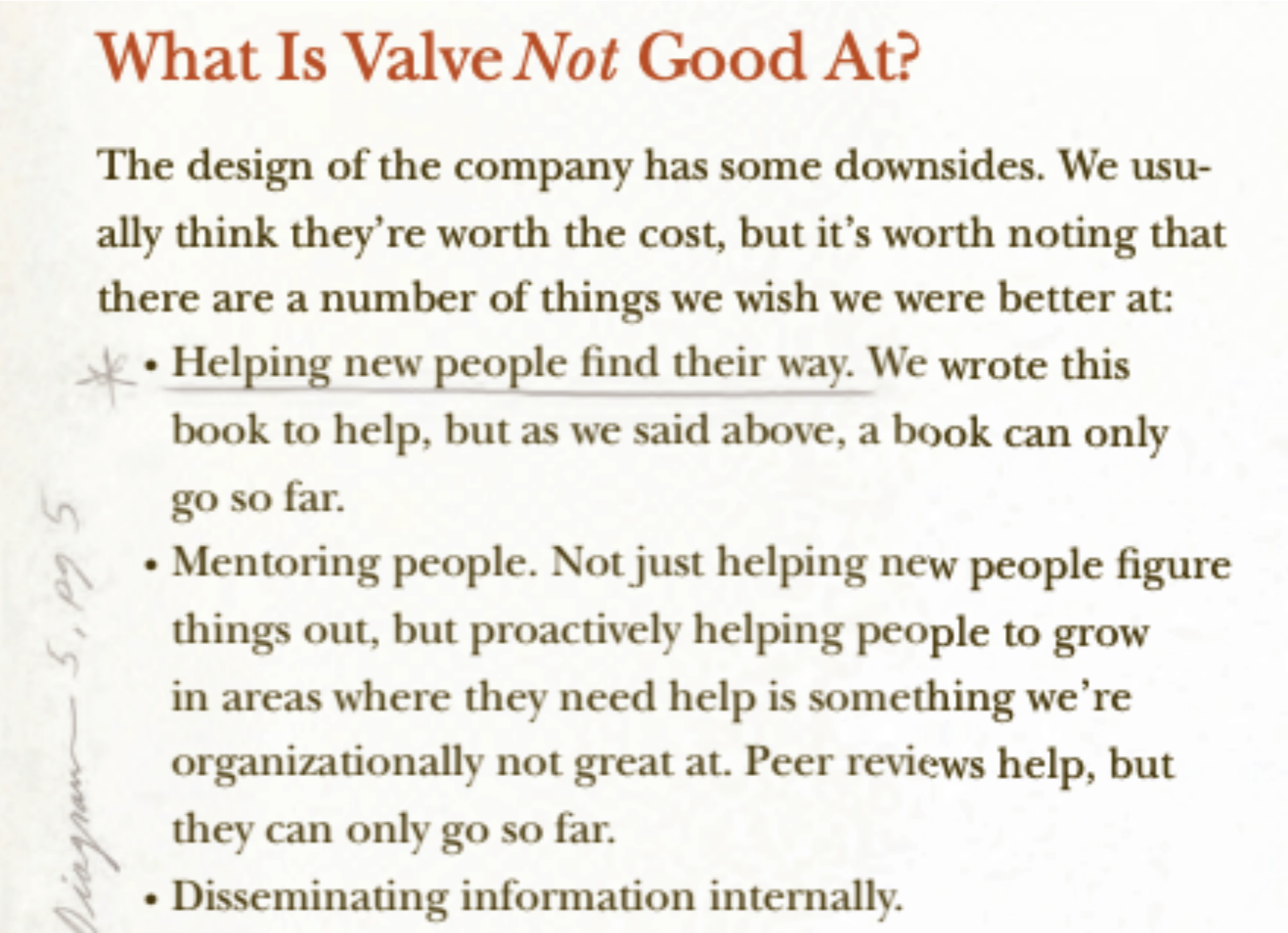
Companies end up developing implicit hierarchies of information availability, even if no formal hierarchies exist. Knowledge, as they say, is power. If conversations, transactions, and processes are publicly available, anyone can (at least in theory) enter the organization and contribute positively to it.
Minimum viable self-governance
Autonomy means individuals can make execution decisions without bureaucratic processes that constrain their decision-making authority. The problem with rules or processes is that they can be captured by special interests who use them to retain power instead of for the common good. An example of this is the United States House Rules and Manual, which contains hundreds of pages of drivel like this:
A reappropriation of unexpended balances of appropriations may not be reported in a general appropriation bill, and may not be in order as an amendment thereto…
Rules beget more rules, followed by processes to make sure rules are followed. Rules that determine available actions are inherently political tools. Before long, the meta-game of rule making becomes the primary force for executing the will of power, regardless of how useful the outcomes of this process are. This was one of the primary fears of the US founding fathers in designing a system of governance.
But rules exist for a reason. Resources are constrained, and if anyone can do anything with collective resources, they are quickly diminished in a tragedy of the commons. What is needed to solve this problem is minimum viable self-governance. Elinor Ostrom’s design principles for common pool resource institutions is the leading framework for how humans have solved this problem in a bottom-up way for millennia.
More recent thinking on lorecraft is an interesting reframing of the rules problem. By focusing on memetic tools for building cultural stories, lore is a compelling alternative to rules-based systems. Telling stories about cultural norms is a powerful narrative tool for organizing without adding process.
3 - Empower mission-driven leaders
There’s no such thing as a leaderless organization. When you try to build perfectly flat organizations, you just end up hiding hierarchy in illegible ways, which seems to be an issue at Valve. While transparent and accessible information can help combat this, the most illegible hierarchies form when groups pretend they don’t exist.
When we say mission-driven leaders, we mean it in two ways. First, it means that the best leaders are missionaries, not mercenaries. They believe in and are dedicated to the greater mission of the organization. Second, it means that leadership is a temporary, transient role designed to solve for a specific mission.
DAOs offer a unique solution to this problem that hasn’t been technically feasible before: put direct executive power in the hands of all individuals in an organization. In his anti-capture framework, Spencer Graham identifies direct executive power as the key to successful decentralized organizations:
Separation between decision-making and executive power is uniquely possible within capture-resistant structures. It is why decentralized decision-making is not a strict requirement. It is also why decentralized organizations can be fluid and adaptable. When executive power is decentralized, leadership can truly emerge from anywhere.
Humans want and need leaders to create shelling points for collective action. DAOs should be leaderful organizations — groups that support just-in-time leadership from a wide range of capable individuals. A leader is whoever knows what to do next. Effective DAOs give members the tools to execute when they are the best leader for a shared cause.
While Amazon is well known for their use of two-pizza teams, what’s less well known is that this type of leadership––known internally as single threaded owners––is considered even more important for team cohesion and success. This type of fluid leadership only works if people within the organization have a strong bias towards action. The organization must be designed to support people taking the initiative to step into self-defined leadership roles and making things happen.
4 - Have a bias towards action
The CIA wrote a fascinating manual called the Simple Sabotage Field Manual. In addition to detailed tips and tricks for starting fires, targeting warehouses, destroying tools, and clogging toilets, the manual includes an entire section on undermining the work of organizations. The manual describes the failure state of organizations that have unclear leadership and a lack of bias towards action:

Anyone who has ever been in an organization attempting too much flatness and consensus has probably experienced these problems. This was the downfall of intentional living communes of the 60s and larger experiments in communism through the 1990s. When everyone has an equal voice in everything all of the time, groups end up talking a lot and accomplishing nothing.
One antidote to this problem comes from co-living communities, which are often organized around a principle called do-ocracy. This principle states that, generally, whoever actually does the thing makes the rules. Phil Levin, one of Cabin’s city council members and founder of several successful co-living communities, put together a fantastic presentation called What DAOs can learn from co-living communities. The communities Phil has started thrive on the principle of self-appointed do-ocratic leadership:
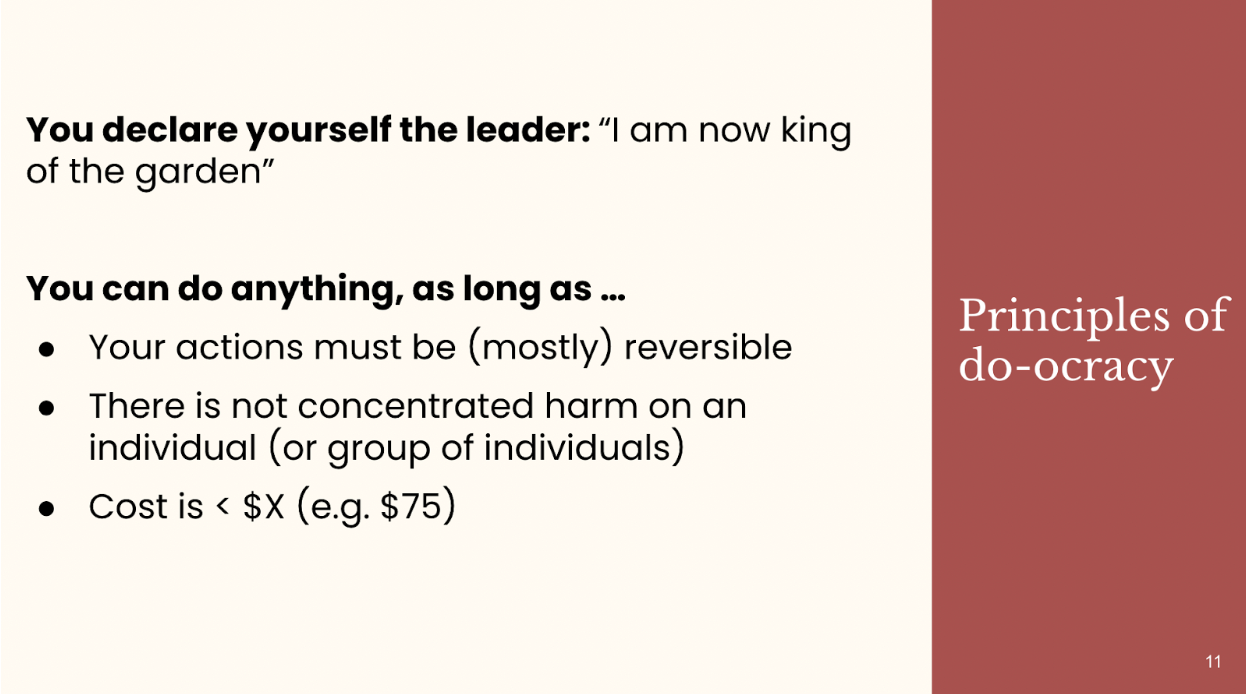
The goal is to minimize governance and consensus decision-making by empowering individuals to make autonomous actions as long as they are reversible and inexpensive. Another good example of this type of decentralized leadership comes from Cabin’s Build Weeks.
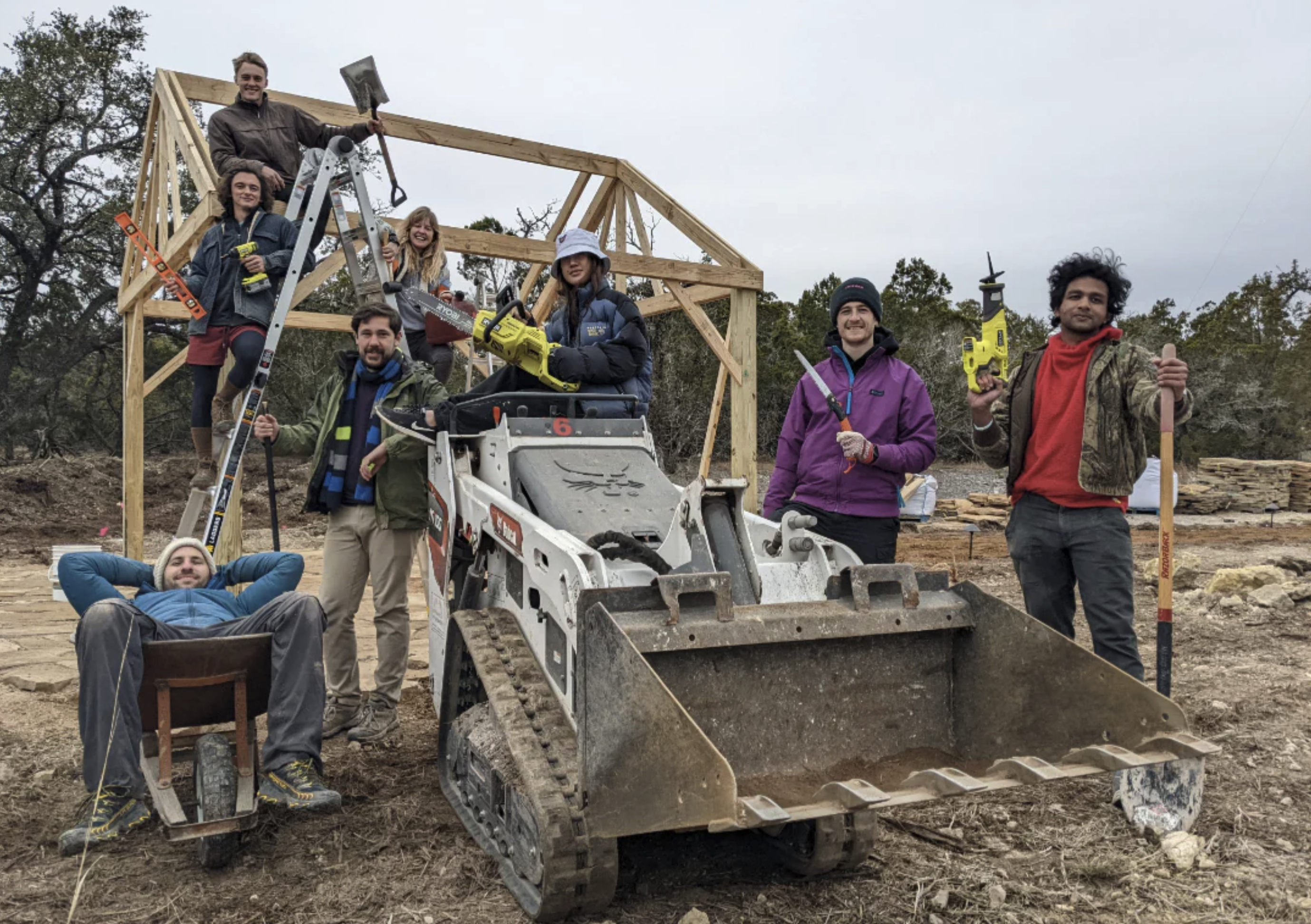
Build Weeks are self-organized by a primary build leader, and also support room for other builders to go on do-ocratic side quests that contribute to the built environment of Cabin’s Neighborhood Zero. Here’s how participants in a recent Build Week described effective do-ocracy:
Despite a lack of stringent roles and duties, everything got done, we were able to use our unique skills and interests without any conflict, and most importantly, everyone got to drive the skidsteer.
Valve also emphasizes a do-ocratic approach to product development, where anyone can “come up with a bright idea, tell a coworker about it, work on it together, and ship it”:
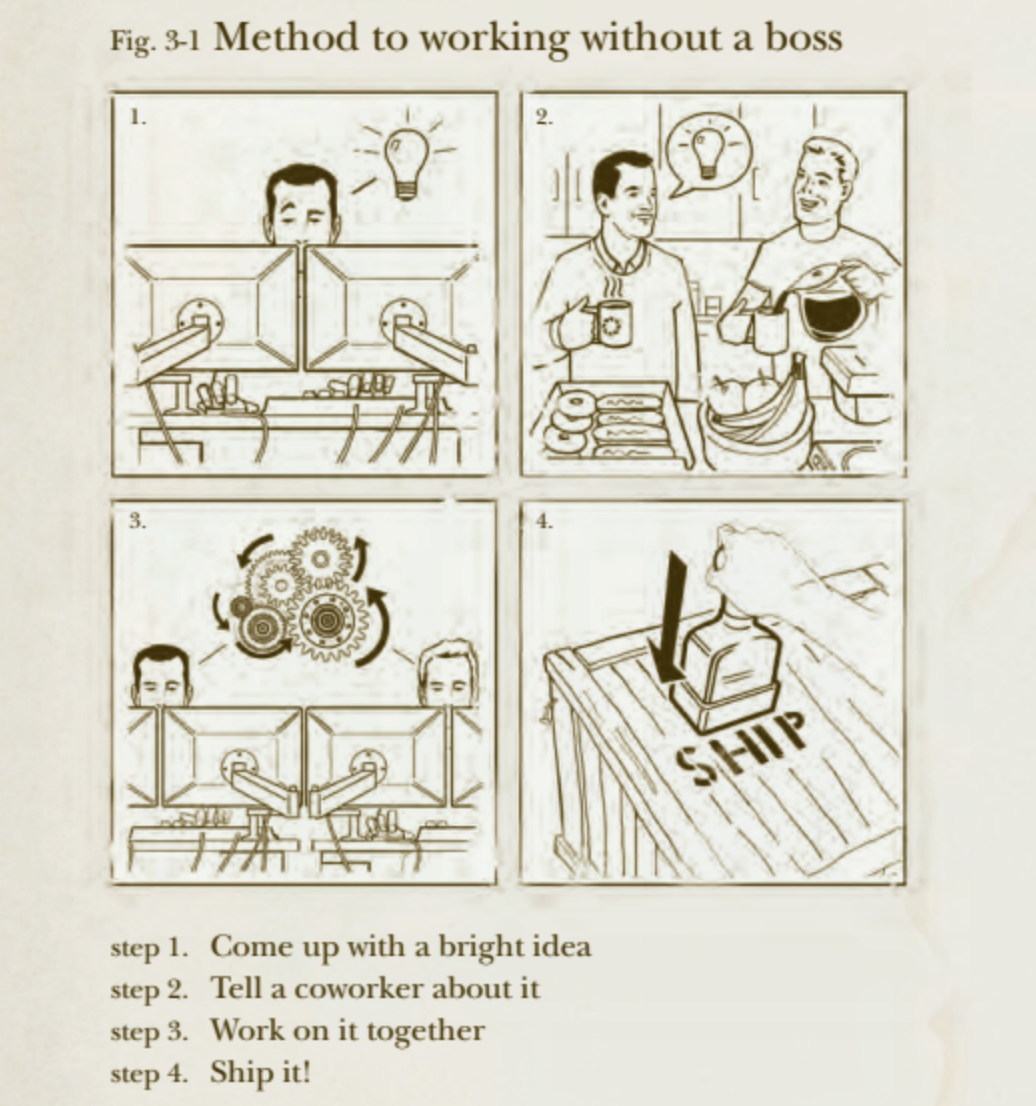
To make this work, you need to design your organizational processes to explicitly reward people trying new things. As Jim Mattis explains:
Instillation of personal initiative and risk taking doesn't spring forward spontaneously. It must be cultivated and rewarded in an organization's culture […] Be tolerant of mistakes. If risk takers are punished, then you will retain only the risk averse.
When things don’t go well, ask yourself: is it because someone took strong initiative and the experiment failed, or because they failed to take the initiative in the first place?
5 - Play infinite games
Rewarding leaders with a bias towards action is key to successfully executing as a decentralized organization. But execution is a finite game—a convergent action to accomplish a specific goal. The final principle of effective decentralized organizations is inherently divergent: play infinite games.
Vibes, reciprocity, and trust are infinite games. They are not played to win, but to keep playing. Infinite games are played for intrinsic rewards:
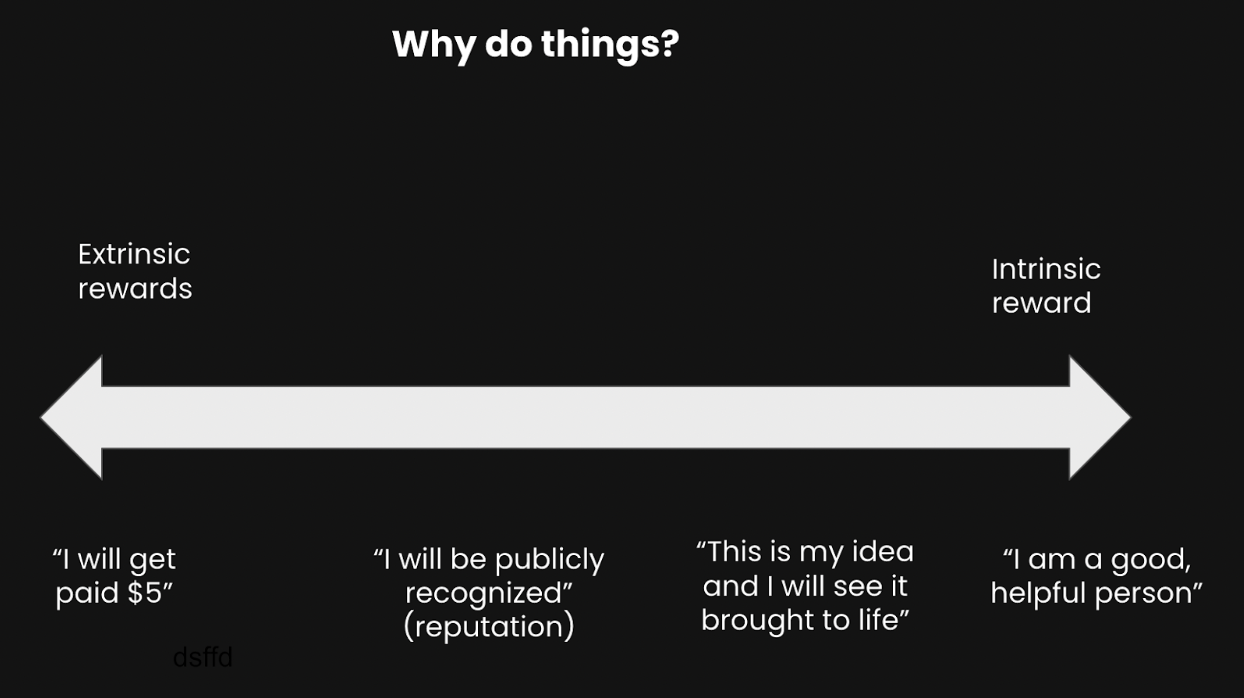
The co-living communities Phil has helped start revolve around the principle of intrinsic rewards. Phil’s partner Kristen, a behavioral scientist, knew that intrinsic rewards are a much more powerful and fulfilling form of motivation than extrinsic ones. As a result, their co-living communities do not offer direct compensation for essentially any work within the community. This policy has ultimately made the community stronger and more productive than if everyone played finite games of resource allocation.
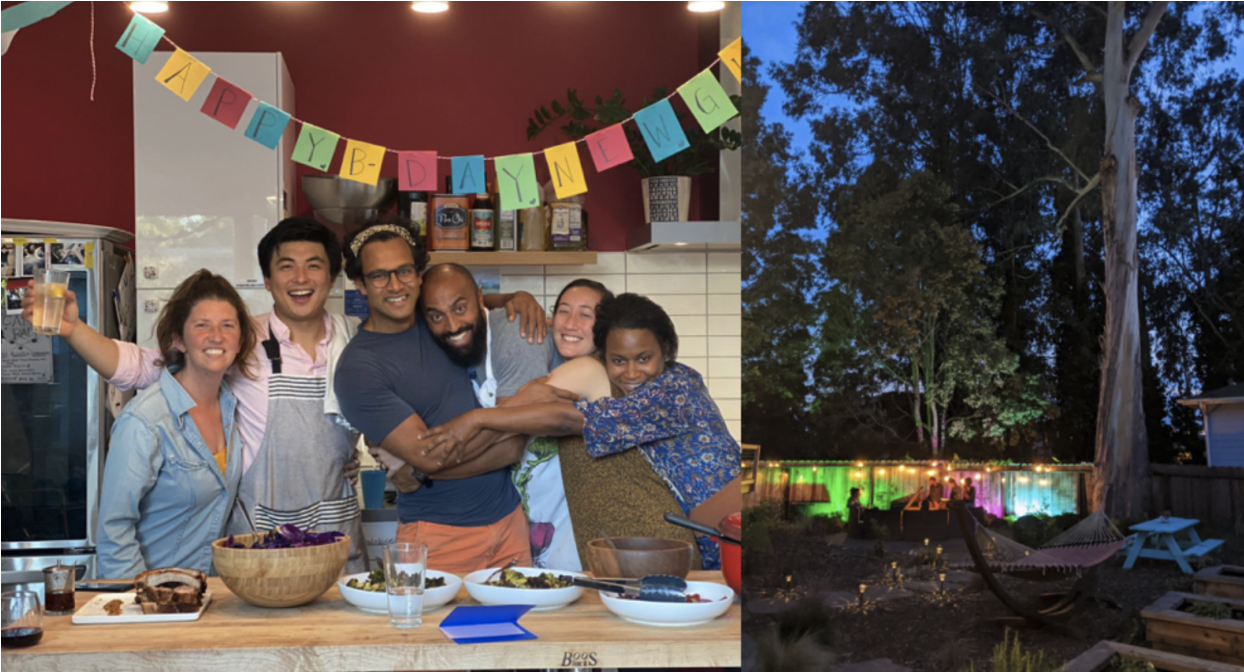
Intrinsic community building means valuing community members beyond the work they do for the organization and allowing people to contribute to the community without expecting extrinsic rewards. While the work of a DAO should reward excellent executors with increased responsibility and financial upside, the whole community does not need to be held to the same standard because the motivations for participation are different. Communities are about vibes and relationships — both of which are driven by intrinsic motivation and infinite games.
Infinite games will take DAOs to interesting places. Amazon is playing an infinite game. Notice what’s missing from Amazon’s famous flywheel—any arrows leaving the diagram:
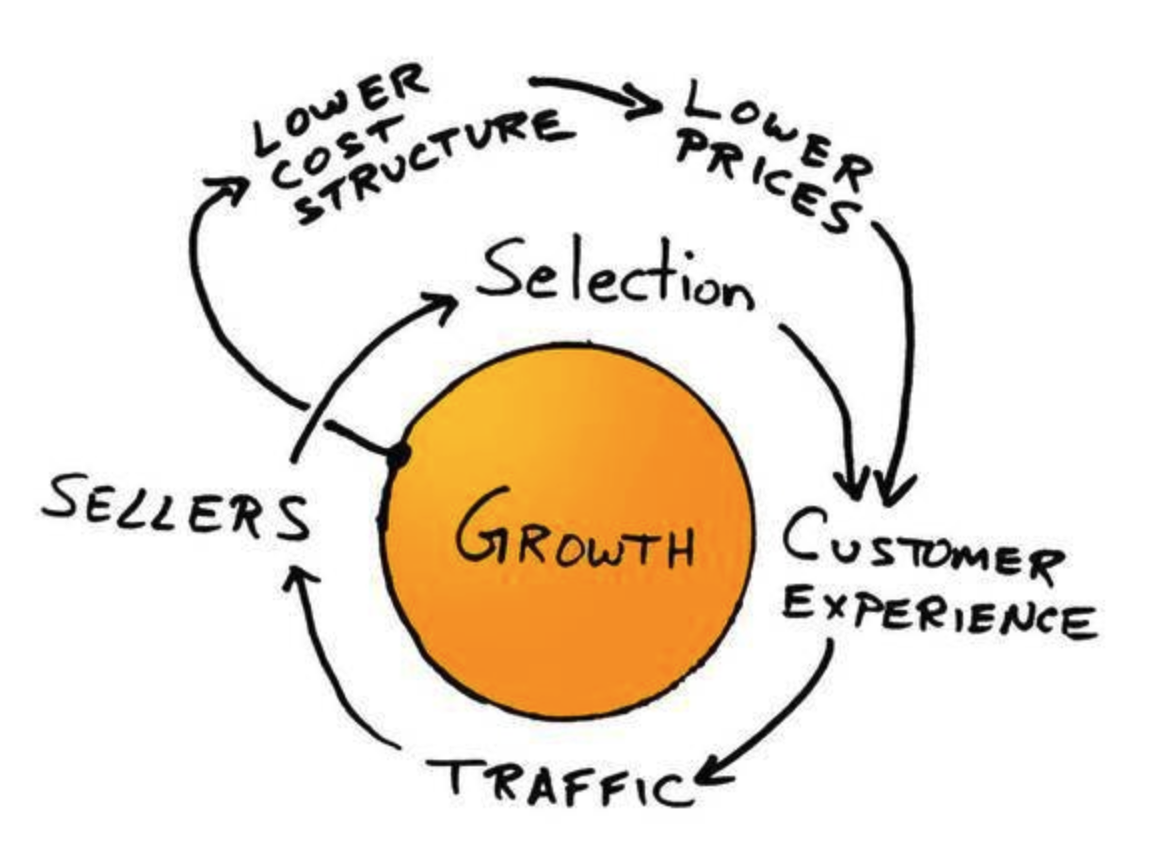
Amazon is one of the world’s most powerful self-perpetuating economic feedback loops. It is a mechanism for feeding back on its own growth, which creates exponential growth in revenue without capturing profits:
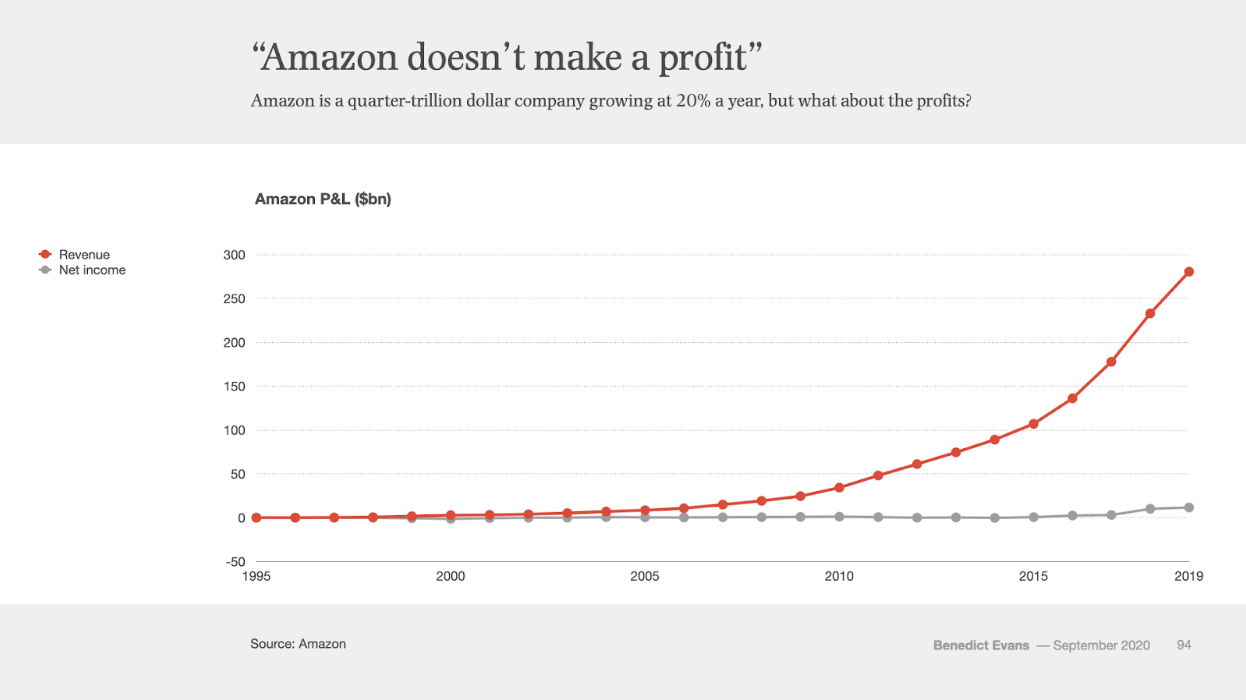
The most potent DAOs will follow a similar path—they will create intrinsically motivated communities that self-perpetuate memes and culture while simultaneously developing protocol hyperstructures that live indefinitely and create value without necessarily extracting profits.
This is the end state of sufficiently decentralized organizations that points us towards a future that companies are not designed to produce. Organizations of the future can be collectively owned and organized around a token that provides utility to those who hold or stake it and that never attempts to produce dividends or profits that are extracted from the system—all while still providing massive value to network participants. Like ecosystems, economies, and other forms of complex adaptive systems, DAOs can be structures for playing infinite self–fulfilling games that reward participants with meaning and purpose.
The DAO playbook
No two DAOs will be able to follow the exact same playbook, because their purposes, communities, and resources will look different. But, like companies, a diversity of products, business models, and cultures will develop in DAOs—and there will be repeatable patterns of success in the ways organizations treat DAO as a verb.
Ultimately, by integrating the ways that centralized hierarchies create efficiency and decentralized networks create resilience, we can chart a path towards more effective organizations. Charting this path will require a deep understanding of historical precedent and a penchant for constant experimentation. No matter what these organizations of the future end up looking like, the ones that succeed will probably do these things:
-
Recruit the best people
-
Help members self-organize
-
Empower mission-driven leaders
-
Have a bias towards action
-
Play infinite games
thanks to Phil Levin, Zakk Fleischmann, Chase Chapman, Commodore, Erik Trautman, Allen Taylor, Spencer Graham, and Rafa Fernandez for ideas and edits reflected in this essay
[originally published June 6th, 2022]